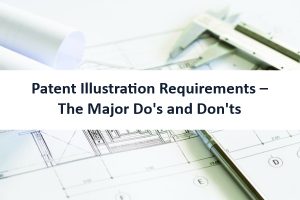Every applicant, seeking a patent, must know the importance of a patent drawing in a patent application. The USPTO Patent Drawing Rules do not allow the applications with no patent drawings. Moreover, an applicant must include as many drawings as he can in his application. Drawings are helpful, and adding different views makes it easy for an examiner to understand an invention. The USPTO has set patent drawing rules that applicants must adhere to when filing a patent. A patent application, which doesn’t follow Patent Drawing Rules, gets rejected. Also, drawings show how an invention looks and functions.
Related article: The Basics of Design Patent
The USPTO Patent Drawing Rules
The USPTO Patent Drawing Rules is a long and extensive list. An applicant must follow the standards while filing a patent. The following are the standards that an applicant must see.
Colour
An applicant may furnish drawings made with either black ink or color in utility and design patent applications.
Black ink
Commonly, black and white drawings are provided to the Office at the time of patent filing. More importantly, India ink or its equivalent ink must be used for drawings.
Colour
Rarely, colour drawings are a part of an application. If to disclose a subject matter is to furnish the drawings in colour, the Office may accept the colour drawings. Also, colour drawings provided by applicants should be reproducible in black and white. However, filing globally, applicants aren’t allowed to furnish colour drawings when the application is submitted under the Office electronic filing system.
Photographs
Generally, photographs and their photocopies aren’t allowed in utility and design patent applications. However, in exceptional cases, photographs are allowed in applications. Moreover, the photographs must be reproducible in the printed patent. Two categories are available: Black & White and Colour.
Identification
Applicants must mention the title of the invention, inventor’s name, and application number, or docket number. The aforementioned information must be mentioned within the top margin on the front of each drawing sheet. Moreover, sheets provided after the filing date of an application are identified as either “Replacement Sheet” or “New Sheet”.
Graphic Forms
Applicants may submit mathematical formulae, tables, and waveforms in applications. However, these graphic forms are treated as drawings. Every chemical and mathematical formula is a separate figure and should be labelled separately. Likewise, every waveform is a different figure and labelled separately.
Margins
Each drawing sheet must maintain the top, right, bottom, and left margin.
- A top margin must be at least 2.5 cm.
- A left-side margin must be at least 2.5 cm.
- A right-side margin must be at least 1.5 cm, and
- A bottom margin must be at least 1 cm.
Views
Applicants must include maximum views in their patent applications. Also, keep the views of drawings together in an upright position. There are various views available: Exploded views, Partial Views, Sectional Views, Alternate Position, and Modified forms.
A drawing must show the mechanism of an invention. Also, it must not get crowded when it’s reduced to two-thirds of the original size.
Lines, number, and letters
Draw every line, number, and letter in such a way that the reproduction of a drawing gives a satisfactory output. Every line, number, and letter must be sufficiently dense and dark, uniformly thick and well defined, and clean. Lines having different thickness have a different meaning. As a result, applicants can use different lines in a drawing to represent different meanings.
Shadings
Shading is acceptable with the drawings, but it must not reduce the readability of drawings. However, you may avoid shading in a drawing. Instead of shading, applicants may use heavy lines on the shade side of the object.
Symbols
Universally not recognised symbols are accepted only if they can be easily separated from existing conventional symbols.
Legends
Legends should be short and descriptive. They are used to ease the understanding of the drawing by the examiner. However, legends are subject to approval by the Office.
Numbers, letters, and reference characters
Reference characters, drawing sheet numbers, and view numbers must be readable. The height of numbers, letters, and reference characters must be at least .32 cm. Use English alphabets for letters. Whereas, use Greek alphabet to represent angles, wavelengths, and mathematical formulas. Moreover, one must use same reference character for the same part of invention existing in more than one view.
Lead Lines
Lead lines are the Lines lying between the reference characters and the details. Also, these lines should be short or curve or straight.
Arrows
Arrow in a drawing shows the direction of movement. Also, a free-standing arrow on a lead line indicates the section it points to. Moreover, an arrow touching a line on a lead line indicates the surface shown by the line.
Copyright or Mask Work Notice
Applicants may include Copyright or Mask Work Notice in the drawing just below the figure. However, Copyright or Mask Work Notice must be of limited letters and size between 0.32 cm and 0.64 cm. The USPTO has mentioned two examples of Copyright or Mask Work Notice: “©1983 John Doe” (17 U.S.C. 401) and “*M* John Doe” (17 U.S.C. 909).
The numbering of sheets of drawings
One must do proper numbering on the drawing sheet. Starting with 1, Use Arabic numerals for numbering. The numbering of views is independent of numbering on drawing sheets. Show the numbering as “FIG.” In the case of a single view, no need to mention “FIG.”
Security Markings
Authorized security markings may be placed on the drawings provided they are outside the sight, preferably centered in the top margin.
Corrections
Corrections on drawings must be durable and permanent.
Holes
No holes must be present in drawing sheets.
Related Article: Design Patent Cost: How much is it?
Models, Exhibits, and Specimens
Generally, Models or exhibits aren’t necessary for the patent application. The description of an invention and drawings must be enough to disclose the invention publically. However, in some cases, the Office may ask for a working model. The application seeking a patent of the invention related to the composition of matter may require specimens.
Related Article: Design Patent Illustration Requirements – Things You Need to Know
Why are Patent Drawing Rules important to follow?
An applicant must file a patent in compliance with patent drawing rules. The USPTO has already mentioned patent drawing rules on its website. Moreover, an examiner may approve the application if it’s formatted properly. Also, the USPTO Patent Drawing Rules are to avoid confusion in a patent application.
Patent Illustration Express complies with Patent Drawing Rules
Patent Illustration Express (PIE) is based out of the U.S. Having served clients in more than 45 countries, PIE is a market leader and offers “super-fast” patent illustration services in compliance with Patent Drawing Rules. If you have doubts or a second thought about the company, you may ask for samples. Also, PIE has assisted many clients, and you may see their testimonials on the PIE website. We offer world-class services at optimum cost. Don’t believe us, check our pricing here.
Other Related Article
Benefits of Patent Drafting Service



